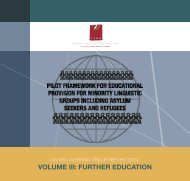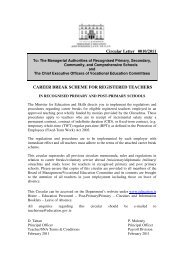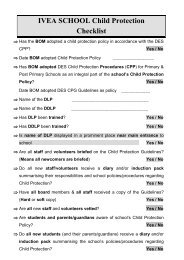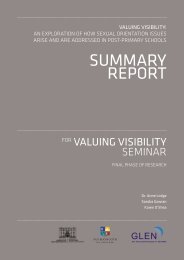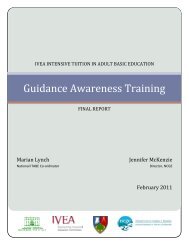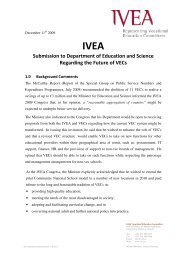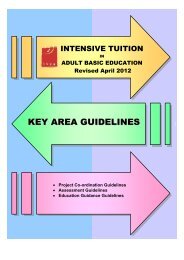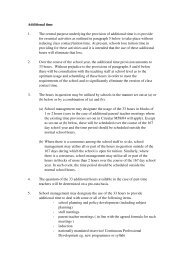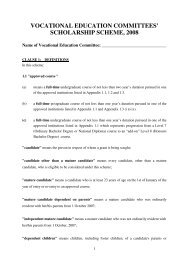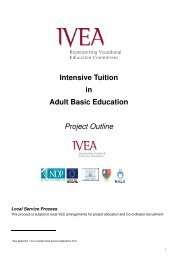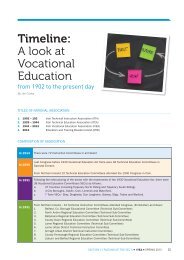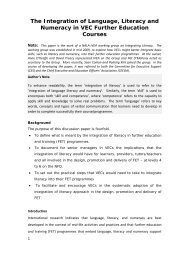Download File - IVEA
Download File - IVEA
Download File - IVEA
Create successful ePaper yourself
Turn your PDF publications into a flip-book with our unique Google optimized e-Paper software.
epresenting this diversity, visual acknowledgement of<br />
achievements based on multiple intelligences, art-work with a<br />
global perspective and notices/symbols that draw attention to<br />
celebrations of different faiths.<br />
• Where possible, schools should try to promote interfaith services<br />
and understanding of common beliefs.<br />
• It is important for schools to have clear guidelines on behaviour<br />
for students and parents and these guidelines should include the<br />
school’s anti-bullying and anti-racism policies.<br />
• Where possible, and if necessary, with the help of interpreters,<br />
enrolment practices should include building up a profile of a new<br />
student with particular reference to previous schooling, language<br />
abilities and religious affiliation [refer to section 6.3].<br />
• The issue of enrolment in second-level schools needs to be<br />
addressed at national policy level to address the issue of students<br />
being refused admission to certain schools without obvious reason.<br />
School Code of Behaviour<br />
The school’s code of behaviour is an important tool in achieving<br />
equality. The code of behaviour should explicitly name the nine<br />
grounds listed in the Equal Status Act, including religion and race, and<br />
require behaviour that respects diversity across them. It should prohibit<br />
harassment. The code should set out the policy and procedures to<br />
deal with harassment across all of the grounds and should identify<br />
action to ensure such harassment does not occur and the steps that<br />
will be taken if it does occur. Schools and the Equal Status Act states:<br />
steps to prevent harassment occurring include ensuring all members of<br />
the school community – including parents and staff – are made aware<br />
of the code of behaviour and that harassment and sexual harassment<br />
are prohibited. Other steps include: building an anti-harassment culture<br />
through training for both staff and students. Proper implementation<br />
of the procedures when incidents do occur is essential in preventing<br />
future harassment. The preparation of the code of behaviour should<br />
involve consultation with parents, teachers, principals and pupils.<br />
Example of Best Practice: Castleknock Community College<br />
Castleknock Community College has implemented the following<br />
initiatives in promoting inclusivity, interculturalism and equality in the<br />
school 45 . This list is by no means exhaustive and may be adapted<br />
to suit the individual needs of each school.<br />
• Student Mentoring Programme;<br />
• “Buddy” System; (this recommendation is also supported by Tralee<br />
Community College);<br />
• Additional English Classes – withdrawal (Learning Support<br />
Department);<br />
• Adult Education classes & ESOL classes;<br />
• Integration of students in the new Religious Education Programme<br />
for all faiths or none;<br />
• Provision of different language opportunities for non-national<br />
students, e.g. Leaving Certificate Russian;<br />
• Establishment of links with primary feeder schools with a view to<br />
make the transition to second level as smooth as possible;<br />
• Encouraging parents to bring along an interpreter to Information<br />
Evenings, parent/teacher meetings etc.;<br />
• Student Council Meetings that feed directly to school management;<br />
• Anti-Racism campaigns;<br />
• Anti-Bullying campaigns;<br />
• Refugee Solidarity Badge (launched by Mary Robinson);<br />
• Amnesty S.A.Y. 46 groups;<br />
• Links with UNIFEM 47 to make connections with the women and<br />
children of Afghanistan who have visited classes;<br />
• Fund-raising for group mentioned above and others;<br />
• Currently working on school flag with languages of all the different<br />
nationalities represented;<br />
• Visits to C.S.P.E. classes by representatives of the Refugee Agency;<br />
• School Inter-Faith Ceremonies.<br />
5.2.2 Using the Whole School Approach<br />
The <strong>IVEA</strong>, in addition to agencies including the Equality Authority and<br />
the Department of Education and Science, recommends the whole<br />
school approach as the most effective way to respond to cultural<br />
diversity in schools. Effective anti-racist and inclusive policies are<br />
recommended together with codes of practice and the development of<br />
an intercultural approach to the curriculum.<br />
Schools and the Equal Status Act identifies the School Development<br />
Plan as an appropriate place in which to identify a commitment to<br />
achieving equality. It must contain equality objectives and identify the<br />
steps that will be taken to achieve them. It should be based on an<br />
identification of the educational needs of students across the nine<br />
grounds. Consulting groups that represent those who experience<br />
inequality in the development and monitoring of the plan can help to<br />
inform the school’s commitment to equality.<br />
<strong>IVEA</strong> recommends that schools include all stakeholders: teachers;<br />
administrative staff; students; parents; and boards of management in<br />
20<br />
45<br />
For further information, contact Castleknock Community College at the following address: Carpenterstown Road, Dublin 15. Phone: 01 8412388. Fax: 01 8413818.<br />
46<br />
S.A.Y.: Student and Youth Network. See http://www.amnestry.ie (Youth and Student pages).<br />
47<br />
UNIFEM: United Nations Development Fund for Women. Refer to: http://www.unifem.org/



